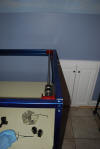|
Basic Overview:
As explained on the opening page for the Mirror Grinding Machine (MGM), this
design is to run under total computer control. There is a 24" diameter
turntable to hold the mirror blank. This is driven by a DC motor (from an
electric wheel chair) to provide variable speed of the turntable. The tool
motion is controlled by two stepper motors controlling an X-Y axis. This
allows the tool to make any path the operator can imagine - from the early W
stroke to final figuring correction (if a particular zone is too high, allow the
machine to spend a slightly high percentage of the time in that zone than the
rest of the mirror). The hardware is finished after 9 months of designing
and 3 months of building. The software is just beginning and may take
another year.
The frame of the MGM is made of 1.5" square steel tubing. I milled a
plug from steel which I welded into the end of several tubes. An internal
ridge in the tube was ground down with a Dremel tool. The plugs were
tapped with a 3/8 x 16 hole.




Once all the parts had been machine, the frame was painted with a cobalt blue
metal flake paint. All moving parts were painted with a red metal flake
paint. They really look good. I once did contract electronics for a
machine shop - the owner had a tongue-in-cheek saying - "It doesn't matter if it
works, as long as it looks good!"
Assembly of the MGM finally begin in early September 2009. The frame
sits on a piece of carpet, which had a 3/4" OSB panel on top, and then another
layer of carpet. The series of images below show the frame being
assembled. The frame is screwed together using 3/8 x 16 button head socket
screws.





The 24" diameter turntable rides on 3 large bearings, but is attached to a 2"
diameter shaft which is attached to the wheel chair DC motor to turn the
turntable.


Once the main part of the frame was assembled, the base plate (.25" Aluminum)
was screwed in place.

Next the top frame work was bolted in place, and the top (which carries the
motors and X-Y carriage and is hinged) was put in place.


With the top frame in place, the motion hardware was installed. First
the .75" Y-Axis rods and supports were attached to the top. Next the
supports for the X-Axis were attached to the linear bearings on the Y-Axis.






With the 1" diameter X-Axis rods in place, the carriage was added.
Followed by the bearing supports for the turntable.


The 24" diameter turntable is actually 4 layers of .25" Aluminum which is
screwed together, It was attached to one end of my milling machine table
and hand turned against an end mill. This gave me a round, smooth surface.
The top was covered with epoxy and sanded down to a flat surface. The
bottom shot shows the 3" diameter Aluminum piece that was milled out to fit the
2" diameter shaft. This was screwed to the 1" thick plate. The
turntable was painted with primer and epoxy enamel before being covered
with a layer of rubber mat. There are three groups of four 1/2 x 20 holes
located 120° apart which will hold the mirror clamps.





Once all the parts were in place, the dual chain (three 1/32" diameter
stainless steel cable covered with polyurethane) was attached to the moving
parts. Stepper motors were added.





And this is the current state of the hardware as of September 10, 2009.


| 